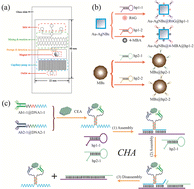A capillary-driven LoC-SERS device integrated with catalytic hairpin assembly amplification technology for NSCLC-related biomarkers detection†
Abstract
In this study, we apply catalytic hairpin assembly (CHA) as the signal amplification strategy for the quantification of carcinoembryonic antigen (CEA) and cytokeratin fragment antigen 21-1 (CYFRA21-1) with a surface-enhanced Raman scattering (SERS) microfluidic chip (LoC-SERS) as the carrier. Herein, antibody–DNA conjugates are designed to assist the application of CHA amplification in protein detection. In the presence of protein biomarkers, antibody–DNA conjugates can specifically bind to the target proteins, forming the antigen@antibody–DNA conjugates. The terminal free part of the DNA on the conjugates can trigger the CHA events to connect SERS nanotags to capture nanoprobes. Then, micro-magnet can gather the CHA products in a rectangular chamber, resulting in the aggregation of SERS nanotags, which can ultimately generate abundant “hot spots” for SERS signal enhancement. Using this strategy, CEA and CYFRA21-1 can be successfully determined with a limit of detection (LOD) as low as pg mL−1, much lower than recently reported methods. Meanwhile, a non-small cell lung cancer (NSCLC)-xenografted mouse model was established, and SERS was applied to analyze the expression level of CEA and CYFRA21-1 in tumorigenesis and development. The comparison between SERS results and those of the ELISA method demonstrated a high degree of consistency, suggesting that the proposed CHA-assisted LoC-SERS device has satisfying accuracy. Thus, introducing the CHA strategy via the design of antibody–DNA conjugates opens new gates to ultra-sensitive and specific SERS detection of protein biomarkers.



 Please wait while we load your content...
Please wait while we load your content...